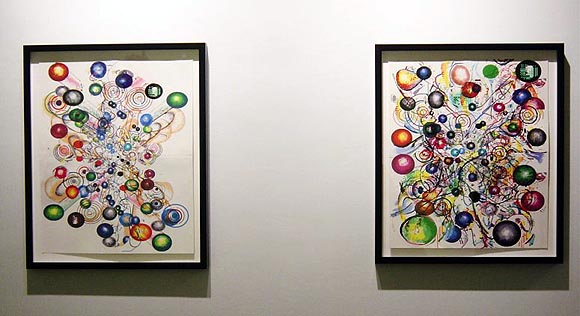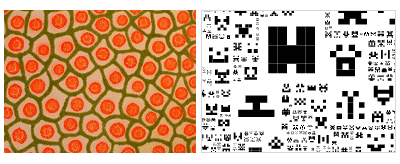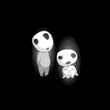View current page
...more recent posts
I have two videos in the upcoming Chicago Underground Film Festival--"Drum Machine" and "End Notes" (w/ jimpunk). Here is the lineup, excerpted from the website:
MOMENTS OF GREATNESS--MUSIC VIDEOSReally proud and excited to be in this company.
Friday August 18
9:45 PM
Theater One, Music Box Theater, 3733 North Southport
Chicago Underground Film Festival
Size matters! Don't miss your chance to check this amazing batch of underground music vids on a screen larger than your toenail. These inspired blasts of low budget, highly creative mindf*cks won't soon be forgotten.
And the music's killer.
Videos include:
Bonnie "Prince" Billy--Horses, directed by Braden King
Black Mountain--Druganaut, directed by Heather Trawick
Jason Forrest--Steppin' Off, directed by Jon Watts
ASCII Rock--My Generation, directed by Yoshi Sodeoka
Bobby Conn and the Glass Gypsies--Home Sweet Home, directed by Usama Alshaibi
The Juan Maclean--Give Me Every Little Thing
End Notes, directed by Tom Moody with Jimpunk
Camero Rougue--Blowin' Yer Top, directed by Ben Redgrave
Animal Collective--The Fickle Cycle, directed by Scott Colburn
The Sea Calls Us Home, directed by Anie Simpson and Seth Kirby
Kaada--Thank You For Giving Me Your Valuable Time, directed by Robert Ruiz De Castilla
FFFF's--Sheets, directed by Brian Henry
The Gossip--Standing in the Way of Control, directed by Wyld File
Drum Machine--Tom Moody
The Mai Shi--Vampire Beats
Negativland--Guns, directed by Peter Neville
Jamie Lidell--New Me, directed by Aleksandra Domanovic
Chemical Brothers--Come Inside, directed by Ik-kyeong Kwon
Starter Set--In Can Can Descent, directed by Lindsay Beamish
Dirty Three with Chan Marshall--Great Waves, directed by Braden King
Antony and the Johnsons--Hope There Is Someone, directed by Glenn Fogel
Thanks to Eyebeam and Rhizome.org* for reblogging the recent post here on Paul Lansky. That writing's been revised a bit, including fixing one unfortunate flub: the phrase "now a kind of parallel universe to the academic camp" in the second paragraph was missing the "the," which made it sound like the post was calling "music department music" camp or kitsch. Some of it is, but not Lansky's. Some more late thoughts on Lansky's essay "The Importance of Being Digital" follow.
A possible contradiction in the essay: Lansky describes in great detail how analog recording errors can mar the pristine perfection of a digital music composition (such errors are called "artifacts," whether analog or digital). He recounts anecdotally, from the bad old days, all the steps involved in transferring a computer music piece of his to vinyl, each of which introduced artifacts. One of his philosophical selling points for digital technology is its ability to make an artifact-free copy, which is then nearly infinitely reproducible on a mass consumption level. (An aside: Lansky's irritability over intrusive sounds explains much about his music, which is remarkably smooth even at its most boisterous.)
Yet while praising the perfect copy Lansky argues for digital music's ability to exploit the "loudspeaker as instrument." In other words, the speaker is not just a window through which a pre-existing sound reality passes. Woofers and tweeters (and the creators who control them) can actively shape and define their own sonic reality. But if that is the case, why is purity of signal such a virtue? Does clarity even exist if no comparison is to be made to a pre-existing sound?
Lansky describes how analog copying procedures carry with them their own history. A grainy xerox of a smudged newspaper image of a black and white photo, for example, tells a story as much as the underlying picture. Setting aside the fact that digital production has its own artifacts, such as the non-stop yodeling of a skipping CD: this "history" can be just as much a part of that "loudspeaker reality" Lansky champions. In other words, it can serve as content to be actively used by the composer, whether through the deliberate introduction of skips and errors into the recording process, or by adding a patina of age or "period" to music, as in the distinctive mellow hum of an old tube amp: a mix of fact and fiction to be sorted out by the listener.
The point of all this being not to challenge Lansky's core arguments but simply to demote "purity of signal" in the pantheon of digital music's virtues, significantly below "ease of copying," manipulatability, and "ability to define its own reality." If clarity has a virtue at all, it is, as Lansky suggests, that it allows infinite cutting and pasting in the composition process without changing the sound in undesired ways due to accumulating artifacts. Being able to create a "richer," "fuller" sound from the rich pallette of prior recorded or previously unrecorded sounds allows the composer to more accurately trigger associations in the listener while at the same time plugging this data into the composition's imaginary patchbay of abstraction and representation.
*Update, 2011: Eyebeam reblog archives are dead. The Rhizome link has been changed to http://rhizome.org/editorial/2006/aug/12/p-lansky-club-vs-academic-electronic-music/. Please note that I authored the post, not Marisa Olson.
I've been going back over my YouTube posts from the past few months--a surprisingly large amount are dead links because they've been removed "for terms of service violations" or "by user." Read: people received greasy lawyer letters and got scared. As if some grainy, tiny crap video from the '70s is something anybody deserves to profit from. Amazing how many creative types don't get the viral thing at all.
Lke Anna Karina's Sweater on Oliver Stone's 9/11 movie:
While it is remarkable that anybody was found alive in [the World Trade Center] rubble (McLoughlin and Jimeno were 2 of only 20), I feel that there's something inherently irresponsible in narrowing the focus in order to create an uplifting, feel-good story. It's as if the film exists in a vacuum, and its refusal to acknowledge facts (both pre- and post-event) is not only naive, but also a bit dangerous. This kind of over-simplification is exactly how Bush & Co. would want you to remember that day. That it was simply an act of 'evil' carried out by individuals who hate our freedom. Is it any wonder that right-wing media outlets are praising the film, or that Paramount hired the same PR firm that brought us the Swift boat campaign against Kerry?Armond White weighs in, building up the Stone movie by bashing United 93:
After 9/11, hucksters have had a huge opportunity to trick filmgoers who are unable to distinguish the solemnity of recent history from tacky Hollywood manipulation. During United 93, when I laughed at its preponderance of action-movie cliches, a middle-class woman chided me to “Be respectful!” Respectful of what? Clumsy exploitation-film mechanics!

Animated GIF sketchbook, again
Animated GIFs (for eventual videos) based on time lapse documentation of the making of the above works (the animations are still sketches and will change somewhat):
Animated version of image on left (new): [2.7 MB .GIF]
Image on right (previously posted): [2.6 MB .GIF]

In David Szafranski's paintings, a group of which were linked to here, dataisnature sees some biological and mathematical underpinnings:
It’s the human equivalent of a Diffusion Aggregation Limitation system - whereby particles in solution diffuse randomly until they move near to a piece of solid structure, at which point they come out of solution and form part of the aggregate, resulting in dendritic structures. All of the works have a similar quality and evoke the idea of the human-computer in repetitive sub-routines crystallizing the work into existence.To illustrate the human-computer connection, DIN pairs a detail of a Szafranski painting with a section of a computer-generated drawing by Jared Tarbell (reproduced above). Continuing the conversation and emphasizing the links between "cyber" and "natural" diffusion models, Szafranski, no slouch in the computational department as well being a kick ass painter, has posted a seductive animated GIF [1 MB .GIF] that applies some of the principles of growth and space-filling DIN mentions.
The actual physical makeup of the paintings, though, in contrast to the ethereal GIF and DIN's elegant theory, suggests a more problematic relationship to science. Made of glue, spray paint, and modeling store synthetic grass, in semi-stable combinations certain to give art world painting fetishists fits, the canvases may evoke principles of fractal orderliness on a compositional level, but materially they revel in decay and punk anarchy: the mien of safety pins through the cheek rather than white lab coats.

Miyazaki Forest Spirits - Found GIF
Some thoughts on the amorphous middle ground between between the hissing, honking, and chittering of academic electronic music and the clicks, stabs, and skronks of its club-based variants.
Princeton professor and computer music pioneer Paul Lansky helped lay the groundwork for the economically thriving business of digital sound manipulation, which now includes the time stretching, spectral analysis, morphing techniques being routinely plied at software synthesizer companies like Steinberg and Native Instruments, as further hacked and jacked on thousands of home computer workstations. Lansky's essay The Importance of Being Digital could be a blueprint, or manifesto, for scenesters currently laboring in the trenches. Drawing on his own experience making music with mainframe computers in the '70s, Lansky presents the case for digital production with a theoretical heft usually lacking in chatboard discussions, which are mostly concerned with technical problem-solving: especially compelling is his consideration, based on film theory, of where sound is "located" and the fictions we accept as listeners. Lansky also shines in the studio: hear, for example, his "Night Traffic," 1990 (scroll down for excerpt), which digitally adds pitch and timbre information to the sounds of cars barreling hither and thither on a four lane highway, creating original, listenable music that is both powerful and oddly poignant. Lansky's gravitas and command of the Western tonal pallette puts this closer to the symphonic tradition than any one-off formal experiment.
For a "pop" mirror to Lansky's essay, consider the following review from amazon.com. The topic is the CD Columbia-Princeton Electronic Music Center 1961-1973. A reviewer obviously steeped in that electronic music that evolved out of the club scene--now a kind of parallel universe to the academic camp that is arguably just as vital (see previous posts on the music at Reaktions.com)--yells back across the wormhole to musicians of Lansky's generation who worked with Wollensak tape recorders and refrigerator-sized computers. The review merits sociological attention for the language accommodations the writer makes to explain the academy's music to his own tribe (or I should say, "our own")--mostly cheeky apologies but some deft rock-crit turns of phrase. Lansky, for his part, has made overtures to the popsters from his side of the wormhole, name-checking Autechre and Radiohead (the latter of whom sampled him).
OK, first off, these folks are writing art music, not pop. In fact, they're the folks who brought you "Who Cares If You Listen?" So it's their job not to sound dated, quaint, or collectible, even 30 years (and thousands of Dr. Sample units) later. How well did they do?Some additional thoughts here.
Well, the effect on a dance music-drenched listener like me is kinda like sensory deprivation but more fun. The reptile in my hindbrain hears the electronic tones and expects prominent beat, lots of repetition, and a climactic hook or two. When it fails to get what it expects it zones out, and lets me concentrate on more abstruse things like musical structure, drama, emotion, you know, all the edifying stuff.
All the tracks (sorry, compositions) have that Columbia-Princeton "sound" - sort of a silky, bubbly deluge of myriads of hand-spliced tape snippets and oscillator calibrations. You get the feeling there's a lot of complexity behind the scenes. Despite risk of extra-musical contamination, it's hard to resist looking in the back of the book to find out how they made these pieces.
My favorites follow, your mileage may vary. Charles Dodge's "The Earth's Magnetic Field" features geomagnetic data converted to pitches and sent through a comb filter (a.k.a. flanger with LFO turned off - think Skysaw). "Cortez" by Ingram Marshall is one of those "see how far you can get with one sample" exercises, in this case the syllable "Oh". I like the way things suddenly sweep into focus when the context is revealed. "Out Of Into" by Bulent Arel and Daria Semegen is the soundtrack to an animation, full of fun melodic lines and evocative, dancing timbres. Even my inner reptile liked it.
--John R. Hodgkinson
Jason Uechi's interview with Lansky from '95 (revived in response to this post--cool!) here.
